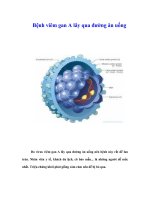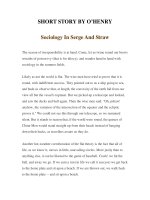Tài liệu Cancer Pain Management: A perspective from the British Pain Society, supported by the Association for Palliative Medicine and the Royal College of General Practitioners docx
Bạn đang xem bản rút gọn của tài liệu. Xem và tải ngay bản đầy đủ của tài liệu tại đây (1.98 MB, 116 trang )
Cancer Pain Management
A perspective from the British Pain Society, supported by the
Association for Palliative Medicine and the Royal College of
General Practitioners
The British Pain Society's
January 2010
To be reviewed January 2013
2
Published by:
The British Pain Society
3rd oor
Churchill House
35 Red Lion Square
London WC1R 4SG
Website: www.britishpainsociety.org
ISBN: 978-0-9551546-7-6
© The British Pain Society 2010
Contents
Page
Preface 5
Executive Summary 7
Chapter 1 Introduction 9
Chapter 2 Pathophysiology of cancer pain and opioid tolerance 15
Chapter 3 Cancer pain assessment 25
Chapter 4 Oncological management of cancer pain 31
Chapter 5 Modern pharmacological management of cancer pain 41
Chapter 6 Psychological aspects and approaches to pain management in cancer survivors 49
Chapter 7 Physical therapies for cancer pain 55
Chapter 8 Invasive procedures for cancer pain 63
Chapter 9 Complementary therapies for cancer pain 73
Chapter 10 Cancer pain management in the community 77
Chapter 11 Pain related to cancer treatments 85
Chapter 12 Management of acute pain in cancer patients 91
Chapter 13 Complex problems in cancer pain 95
Chapter 14 Cancer pain recommendations for service design and training 107
Membership of group and expert contributors 110
3
4
Preface
This discussion document about the management of cancer pain is written from the pain specialists’ perspective
in order to provoke thought and interest through a multimodal approach to the management of cancer pain, and
not just towards the end of life, but also pain at diagnosis, as a consequence of cancer therapies and in cancer
survivors. The document relates the science of pain to the clinical setting and explains the role of psychological,
physical, interventional and complementary therapies in cancer pain.
It is directed at physicians and other healthcare professionals who treat pain from cancer at any stage of the
disease with the hope of raising awareness of the types of therapies that may be appropriate and increasing
awareness of the role of the pain specialist in cancer pain management, which can lead to greater dialogue and
liaison between oncology, specialist pain and palliative care professionals.
The document is accompanied by information for patients that can help them and their carers understand the
available techniques and that will support treatment choices.
Methods
This document has been produced by a consensus group of relevant healthcare professionals and patients’
representatives, making reference to the current body of evidence relating to cancer pain.
5
6
Executive summary
• It is recognised that the World Health Organisation (WHO) analgesic ladder, whilst providing relief of
cancer pain towards the end of life for many suerers worldwide, may have limitations in the context of
long-term survival and increasing disease complexity. In order to address these weaknesses, it is suggested
that a more comprehensive model of cancer pain management is needed that is mechanism-based and
multimodal, using combination therapies including interventions where appropriate, which is tailored to
the needs of an individual, with the aim of optimising pain relief while minimalising adverse eects.
• The neurophysiology of cancer pain is complex: it involves inammatory, neuropathic, ischaemic and
compression mechanisms at multiple sites. A knowledge of these mechanisms and the ability to decide
whether a pain is nociceptive, neuropathic, visceral or a combination of all three will lead to best practice
in pain management.
• People with cancer can report the presence of several dierent anatomical sites of pain, which may be
caused by the cancer, by treatment of cancer, by general debility or by concurrent disorders. Accurate
and meaningful assessment and reassessment of pain is essential and optimises pain relief. History,
examination, psychosocial assessment and accurate record keeping should be routine, with pain and
quality of life measurement tools used where appropriate.
• Radiotherapy, chemotherapy, hormones, bisphosphonates and surgery are all used to treat and palliate
cancers. Combining these treatments with pharmacological and non-pharmocological methods of pain
control can optimise pain relief, but the limitations of these treatments must also be acknowledged.
• Opioids remain the mainstay of cancer pain management, but the long-term consequences of
tolerance, dependency, hyperalgesia and the suppression of the hypothalamic/pituitary axis should be
acknowledged and managed in both non-cancer and cancer pain, in addition to the well-known side-
eects such as constipation. NSAIDs, antiepileptic drugs, tricyclic antidepressants, NMDA antagonists,
sodium channel blockers, topical agents and the neuraxial route of drug administration all have their place
in the management of complex cancer pain.
• Psychological distress increases with the intensity of cancer pain. Cancer pain is often under-reported
and under-treated for a variety of complex reasons, partly due to a number of beliefs held by patients,
families and healthcare professionals. There is evidence that cognitive behavioural techniques that
address catastrophising and promote self-ecacy lead to improved pain management. Group format pain
management programmes could contribute to the care of cancer survivors with persistent pain.
• Physiotherapists and Occupational Therapists have an important role in the management of cancer pain
and have specic skills which enable them to be both patient-focused and holistic. Therapists utilise
strategies which aim to improve patient functioning and quality of life, but the challenge remains for them
to practice in an evidence-based way and more research is urgently needed in this eld.
• Patient selection for an interventional procedure requires knowledge of the disease process, the prognosis,
the expectations of patient and family, careful assessment and discussion with the referring physicians.
There is good evidence for the eectiveness of coeliac plexus neurolysis and intrathecal drug delivery.
Despite the limitations of running randomised controlled trials for interventional procedures in patients
with limited life expectancy and severe pain, there is a body of evidence of data built up over many
years that supports an important role for some procedures, such as cordotomy. Safety, aftercare and the
management of possible complications have to be considered in the decision making process. Where
applied appropriately and carefully at the right time, these procedures can contribute enhanced pain relief,
reduction of medication use and markedly improved quality of life.
7
8
• There is a weak evidence base for the eectiveness of complementary therapies in terms of pain control,
but they may improve wellbeing. Safety issues are also a consideration in this area.
• Patients with cancer pain spend most of their time in the community until their last month of life. Older
patients and those in care homes in particular may have under-treated pain. Primary care teams supported
by palliative care teams are best placed to initiate and manage cancer pain therapy, but education of
patients, carers and healthcare professionals is essential to improve outcomes.
• Surgery, chemotherapy and radiotherapy are cancer treatments that can cause persistent pain in cancer
survivors, up to 50% of whom may experience persistent pain that adversely aects their quality of life.
Awareness of this problem may lead to preventative strategies, but treatment is currently symptom based
and often inadequate.
• Management of acute pain, especially post-operative pain, in patients on high dose opioids is a challenge
that requires in-depth knowledge of pharmacokinetics and the formulation of a careful management plan
to avoid withdrawal symptoms and inadequate pain management.
• Chronic pain after cancer surgery may occur in up to 50% of patients. Risk factors for the development of
chronic pain after breast cancer surgery include: young age, chemo and radiotherapy, poor post-operative
pain control and certain surgical factors. Radiotherapy induced neuropathic pain has become less
prevalent, but can cause long-standing pain and disability.
• Patient education is an eective strategy to reduce pain intensity.
• Cancer pain is often very complex, but the most intractable pain is often neuropathic in origin, arising
from tumour invasion of the meninges, spinal cord and dura, nerve roots, plexuses and peripheral nerves.
Multimodal therapies are necessary.
• The management of cancer pain can and should be improved by better collaboration between the
disciplines of oncology, pain medicine and palliative medicine. This must start in the training programmes
of doctors, but is also needed in established teams in terms of funding, time for joint working and the
education of all healthcare professionals involved in the treatment of cancer pain.
• The principles of pain management and palliative care for adult practice are relevant to paediatrics, but the
adult model cannot be applied directly to children.
Chapter 1 Introduction
Summary
It is recognised that the WHO analgesic ladder, whilst providing relief of cancer pain towards the end of life for
many suerers, may have limitations in the context of long-term survival and increasing disease complexity in
many countries.
It is suggested that a new model of cancer pain management is needed that is mechanism-based and
multimodal, using combination therapies including interventions where appropriate, which is tailored to the
needs of an individual, with the aim of optimising pain relief while minimalising adverse eects.
1.1 Focus and Purpose
The focus of this discussion document is on the patient with cancer pain.
The purpose of this document is:
• To highlight the importance of recognising cancer related pain and to optimise management.
• To acknowledge the achievements and successes of modern multiprofessional pain treatments for
cancer patients.
• To highlight areas of continuing poor achievement and gaps in services.
• To emphasise pain management for the cancer population with evidence based multimodal and
mechanism-based treatments.
• To strengthen the relationship between Palliative Care, Oncology and Pain Medicine.
1.2 Approach to cancer pain management
The optimal control of chronic pain in cancer relies on an understanding of the underlying pathophysiology and
molecular mechanisms involved, examples being:
• Direct tumour invasion of local tissues.
• Metastatic bone pain.
• Osteoporotic bone and degenerative joint pain in older people.
• Visceral obstruction.
• Nerve compression and plexus invasion.
• Ischaemia.
• Inammatory pain.
9
10
• Chemotherapy induced neuropathy, paraneoplastic neuropathy and arthropathy.
• Post-surgical pain and radionecrosis.
Management thus starts with the diagnosis of the cause of pain by clinical assessment and imaging.
The ideal mode of palliation (symptom control) is the removal or minimisation of the cause (i.e. disease-directed
therapies). For example, in malignant bone pain, surgery, chemotherapy, radiotherapy and/or bisphosphonates
may be used. For an infection, antimicrobials or surgical drainage of an abscess may be required.
Alongside disease directed therapy, there are a host of pharmacological and non-pharmacological therapies,
which should be used on an individual basis depending on the specic clinical situation. Cancer pain
management remains an area where, in selected dicult cases, destructive neurosurgical procedures can be
appropriate because the limited life expectancy minimises the risk of secondary deaerentation pain.
1.3 Need for better cancer pain management
Previous data has shown the need for better cancer pain management. UK Cancer Deaths numbered 153,397 in
2004 (UK National audit Oce reports 2000, 2004). A conservative estimate has suggested that 10% fail to receive
eective relief by WHO guidelines; however, this is an underestimation given recent surveys (EPIC 2007, Valeberg,
2008) which show that, in reality, upwards of 30% of patients receive poor pain control, especially in the last year
of their lives Thirty percent represents 46,020 patients “failing per year”. If we add in the gures for troublesome
side-eects, then the present situation is even worse.
This is a higher percentage of uncontrolled pain than has previously been recognized. There is a variety of possible
explanations, including complexity of conditions, better surveys, simple cases being treated within primary care -
with more complex cases therefore being treated within specialised units - and compliance with treatments.
1.4 Role of pain service techniques
Several publications support the role of pain service techniques in cancer pain management (DH, 2002; SIGN,
2000; NICE, 2004).
Previous data has shown how pain services can contribute to better cancer pain management. In the Grampian
survey (Linklater, 2002), regular weekly joint sessions with pain management contributed usefully in 11% of total
cases, with interventions such as nerve blocks performed in 8% of cases. Formal collaboration between palliative
care and pain services have resulted in increased service activity (Kay, 2007).
1.5 Unmet needs
Despite recommendations and the demonstration of patients’ needs, these needs are not being met. The trend
over the past two decades towards excluding pain specialists from mainstream cancer pain management means
that they tend to be called in at a very late stage as a ‘last resort’. Patients may be missing out on the benets of
combined multidisciplinary care combining palliative care and pain medicine.
There is evidence of under-referral and that referral structures are patchy. Pain clinics are not resourced to respond
to needs and the availability of interventions is limited.
There appears to be a lack of engagement with organisational structures such as cancer networks and a lack
of lead intervention as recommended. There is a need to focus on a multidisciplinary approach to cancer pain
management, and training must reect this.
1.6 Working models
The WHO analgesic ladder, which has the clear principle of regular “by the clock” oral medication, has helped
cancer suerers all round the world in a cost-eective manner. However, the increasing complexity of cancer and
its treatment in the developed world has led to a dawning realisation of the limitations of the stepped analgesia
approach. There is a need for dierent working models that recognise the limitations of the WHO ladder (Hanks,
2001; Wien, 2007).
Pain management should not only be considered after all oncological treatments have been exhausted, but
should begin much earlier at pre-diagnosis (NICE, 2004), when pain is often a patient’s presenting symptom.
During a patient’s journey, there will be a need for pain management as a result of cancer treatments (Chapters
11,12) and the development of metastatic disease (chapter 4), in addition to the management of pain at the end
of life. Increasingly, cancer patients are going into remission with an increasing length of survival, but they do
suer from persistent pain (chapter 6) (Ahmedzai, 2000). The importance of holistic care and support throughout
this journey should be acknowledged (Ahmedzai, 2001).
In the treatment of bone pain, the second step on the WHO analgesic ladder is commonly unhelpful, with
inadequate pain relief or the development of undesirable/intolerable side-eects (Eisenberg, 2005). There is
currently no place for interventional treatment on the ladder and the earlier recommendations of a fourth step of
interventional management are not applied widely enough.
The main principles of pain management, including the use of a biopsychosocial approach, should be applied,
rather than simply following the WHO ladder.
Mechanism-based strategies incorporating the recent scientic discoveries of the molecular and cellular changes
in chronic and cancer pain are important. For example, treating bone metastases with bisphosphonates,
neuropathic pain with NMDA antagonists and the use of palliative chemotherapy with biological treatments,
radiation therapy and radioactive isotopes.
There is value in minimally invasive investigations for ‘dicult’ pains, such as bone scans, MRI, CT and
electrophysiological testing. There is a need for clear information on what pain services can provide and how they
may be accessed. Better links between palliative care and specialist pain services are also important.
Care of a patient suering from cancer pain requires a holistic approach combining psychological support, social
support, rehabilitation and pain management in order to provide the best possible quality of life or quality of
death. The WHO 3-step analgesic ladder model has made an enormous contribution, but does have limitations: it
has never been validated and morphine is arguably not the “gold standard”, but rather a standard; non-oral routes
may be better and preferable at times.
It is time to move towards a new model of cancer pain management which is mechanism-based, multimodal,
uses combination therapies, is interventional where justied and advocates personalised medicine with the aim
of optimising pain relief while minimalising adverse eects.
11
12
Figure 1
Figure 2
Sheffield model of supportive care
Treating the cancer, patient and family
Adapted from: Ahmedzai, Walsh
Adapted from: Ahmedzai, Walsh
Seminars in Oncol
Seminars in Oncol
2000
2000
Diagnosis
Diagnosis
Screening
Screening
Investigation
Investigation
Grief / Bereavement
Grief / Bereavement
Disease-directed therapy
Disease-directed therapy
Patient-directed therapy
Patient-directed therapy
Family-directed therapy
Family-directed therapy
Death
Death
Remission Cure Relapse
Remission Cure Relapse
Co-morbidity – Information Side-effects Rehabilitation
Co-morbidity – Information Side-effects Rehabilitation
Information Psychological support Financial help
Information Psychological support Financial help
Survivorship
Supportive Care
References
Ahmedzai SH. Window of opportunity for pain control in the terminally ill. Lancet 2000;357:9265.1304-1305.
Ahmedzai SH, Walsh TD. Palliative medicine and modern cancer care. Seminars Oncology 2001;27:1-6.
DH, Specialised Services National Denition Set 31. Specialised pain management services (adult). Published:
19/12/2002.
Eisenberg. Pain Clinical Updates (2005). Vol X111,(5).
European Pain in Cancer (EPIC) survey (2007). Cited in www.EPICsurvey.com.
Hanks GW, de Conno F, Cherny N, Hanna M, Kalso E, McQuay HJ Mercadante S, Meynadier J, Poulain P, Ripamonti
C, Radbruch L, Casas JR, Sawe J, Twycross RG, Ventafridda V. Morphine and alternative opioids in cancer pain: the
EAPC recommendations. Expert Working Group of the Research Network of the European Association for Palliative
Care. British Journal of Cancer 2001;84:587- 593.
Kay S, Husbands E, Antrobus JH, Munday D. Provision for advanced pain management techniques in adult
palliative care: a national survey of anaesthetic pain specialists. Palliative Medicine 2007;21(4):279-284.
Linklater GT, Leng MEF, Tiernan EJJ, Lee MA, Chambers WA. Pain management services in palliative care: a national
survey. Palliative Medicine 2002;16:435-439.
National Audit Oce Report. The NHS cancer plan: a plan for investment, a plan for reform. Department of Health
2000.
National Audit Oce Report. Tackling cancer: improving the patient journey. Session 2004-5. HC 288. 24 Feb 2005.
NICE Guidance on cancer services. Improving supportive and palliative care for adults with cancer. The manual
2004.
Scottish Intercollegiate Guidelines Network (SIGN), Control of pain in patients with cancer. 44 1899893 17 2. June
2000.
Valeberg BT, Rustoen T, Bjordal K, Hanestad BR, Paul S, Miaskowski C. Self-reported prevalence, etiology, and
characteristics of pain in oncology outpatients. European Journal of Pain 2008;12(5):582-90.
Wien PJ, McQuay HJ. Oral morphine for cancer pain. Cochrane Database of Systematic Reviews 2007;Issue 3. Art.
No.: CD003868.
13
14
Chapter 2 Pathophysiology of cancer pain and opioid
tolerance
Summary
The neurophysiology of cancer pain is complex: it involves inammatory, neuropathic, ischaemic and
compression mechanisms at multiple sites. A knowledge of these mechanisms and the ability to decide
whether a pain is nociceptive, neuropathic, visceral or a combination of all three will lead to best practice in pain
management. Prolonged opioid use may lead to the development of tolerance, hyperalgesia, dependency or
addiction.
2.1 Introduction
• Cancer pain shares the same neuro-patho-physiological pathways as non-cancer pain.
• It is a mixed mechanism pain, rarely presenting as a pure neuropathic, visceral or somatic
pain syndrome. Rather, it may involve inammatory, neuropathic, ischaemic and compressive
mechanisms at multiple sites.
• Development over time is complex and varied, depending on cancer type, treatment regimes and
underlying concurrent morbidities.
• Opioids are the mainstay of treatment and are associated with tolerance. Tolerance, withdrawal,
dependence and addiction are separate states that are frequently confused and used
interchangeably.
15
16
2.2 Normal Pain Transmission
2.2.1 Peripheral (Figure 1)
Figure 1
• There is a transduction of alterations in the milieu via specialised receptors (i.e. mechano
– pressure, acid sensing ion channels – protons, vallinoid receptors – thermal, tyrosine
kinase A (TrKA), nerve growth factor – inammation, etc.).
• Transmission occurs via primary aerents: Aβ low threshold, myelinated, transmit non-
noxious stimuli; Aδ wide-dynamic range, thin myelinated, transmit noxious stimuli; and C
bres wide-dynamic range, non-myelinated, transmit noxious stimuli.
• Transmission in the primary aerents occurs via depolarisation, with sodium and calcium
channels playing a crucial role to synapse in the dorsal horn.
2.2.2 Spinal cord dorsal horn (Figure 2)
Figure 2
• This is ‘divided’ into laminae: Aβ bres terminate in lamina III; Aδ in lamina I, IV/V; and C
bres in lamina II.
Modulation of the primary aerent inputs occurs. Excitation is via stimulation of post-
synaptic receptors such as: N-methyl D aspartate (NMDA); alpha amino hydroxy methyl
isoxazole propionic acid (AMPA); Substance P; and descending serotonin release.
Inhibition is via stimulation of gamma amino butyric acid (GABA) interneurones,
enkephalin release (opioid receptors) and descending pathways (Noradrenergic or
Serotoninergic).
• Glial cells (microglia and astrocytes) are crucial to the regulation of synaptic glutamate,
and to the initiation and maintenance of neuronal activation.
17
18
2.2.3 Central (ascending) (Figure 3)
Figure 3
• The ascending pathways are the spinothalamic and parabrachial neurones.
• The spinothalamic neurones connect the dorsal horn via the thalamus to the cortex.
These give intensity and the topographic location of stimuli.
• The parabrachial neurones connect lamina I to the hypothalamus and amygdala
structures. These give rise to the aective component of pain.
2.2.4 Central (descending)
• These arise within the periaquaductal grey (PAG) and rostroventromedulla (RVM), and
connect back to the dorsal horn.
• The descending noradrenergic pathways are inhibitory, whilst serotonin can be either
inhibitory or excitatory (via 5HT3 receptors on primary aerents).
2.3 Neuropathic Pain
• This arises from damage to neurones, either peripheral or central (via compression, ischaemia /
haemorrhage, chemical or transection).
• Peripheral damage results in the accumulation of abnormal sodium and calcium channels at the
site of the injury.
• There is a gene expression alteration in the number and character of receptors.
• Damaged neurones discharge spontaneously, and there is cross-talk to normal bres and the
recruitment of silent nociceptors.
• An excessive or absent discharge from primary aerents within the dorsal horn results in an overall
excitation and alteration in the expression of NMDA receptors and a functional loss of opioid and
gabaminergic systems.
• There is resultant hyperexcitation with increased receptive elds, primary and secondary
hyperalgesia and allodynia.
• Higher centres undergo re-mapping and alteration, resulting in an increased excitation of aerent
and cingulate cortices.
2.4 Inammatory Pain
• Peripheral and central mediators of inammation, such as bradykinins, a nerve growth factor,
cytokines, ATP and protons (from dying cells), establish a feed-forward loop that results in the
sensitisation of primary aerents, the recruitment of silent nociceptors and peripheral hyperalgesia.
• The dorsal horn is hyper-excited, which results from an increase in the primary aerent discharge
and the activation of microglia.
• Inhibition is peripheral via the activation of peripheral and central opioid receptors, COX pathways
and descending modulation.
2.5 Visceral Pain
• This is fundamentally dierent from somatic pain. Symptoms include diuse, poorly localised pain
with dierent descriptors (i.e. spasm, heavy feeling).
• Visceral innervation is two-fold: autonomic (i.e. vagal) and spinal.
• Eective stimuli include: chemical, ischaemic, inammatory, compression and distension–
contraction.
• Key transmitters include: peripheral and central serotonin, calcitonin-gene-related peptide,
vasoactive intestinal peptide and kinins.
• Dorsal horn modulation is transmitted centrally via the spino-thalamic cortex to the viscero-sensory
cortex (mid-insular), where viscero-visceral cross-talk occurs.
• Dorsal columns relay predominately to the thalamus, giving rise to strong autonomic responses
and aerent responses.
• There is cross-talk to the somatic sensory cortex and insular cortices.
19
20
2.6 Cancer Induced Pain
• Animal models allow detailed investigation of the neuro-mechanisms of pain, although these can
only give insight into part of the overall complexity. Nevertheless, they do allow the development
and trial of novel therapies. Unfortunately, there are relatively few animal models of cancer induced
pain.
2.6.1 Cancer-Induced Bone Pain (CIBP) (Figure 4)
Figure 4
• Over the past decade, several murine models of contained bone tumour growth (cancer,
sarcoma and myeloma cells) have been developed, and pain development parallels the
clinical picture.
• Bone is highly innervated with C bres, which are triggered by an inammatory initrate
(secondary to cancer cells) and others (including acid, cytokine, growth factors, etc.),
along with primary aerent destruction (following osteoclast activation).
• The dorsal horn shows a unique pattern of excitation (neither pure neuropathic nor
inammatory), increased wide-dynamic range neurones in lamina I cells (50% compared
with 25% in normals), hyper-excitation lamina I and V, increased glia activation and
dynorphin expression.
• There is attenuation of CIBP via opioids (although this is less ecacious than for
inammation), gabapentin and peripheral inhibitors such as osteoprogeterin (inhibits
osteoblast-osteoclast) TrKA receptor antagonist and endothelial receptor antagonists.
2.6.2 Cancer Therapy Induced Pain
• Murine models of chemotherapy induced pain allow the investigation of cancer
neuropathies with particular interest in taxols, platins, thalidomide, bortezomib, etc., or
direct inoculation of the tumour cells around nerves.
• Cancer neuropathies have disadvantages in transient aerent alterations and a decline
in motor function. Local inammatory inltrates and neuropathic damage illustrate the
unique syndrome.
• Chemotherapy induced neuropathies have illustrated the diverse and unique nature
of damage, including taxol interruption of microtubular aggregation, accumulation in
dorsal root ganglia and the activation of a neuro-immune reaction, which may account
for the side-eects of taxols.
2.7 Opioid Therapy (Figure 5)
Figure 5
• This remains the mainstay analgesia for all cancer pain.
• The practice of opioid switching in order to improve analgesia while minimising side-eects is
recommended after careful consideration and titration. While this is poorly explained at a receptor
level (theories include genomic variations, altered internalisation or the activation of receptors to
dierent opioids), clinical evidence in its favour is building.
21
22
2.7.1 Opioid hyperalgesia
• Increasing doses of opioids can be associated with hypersensitivity of the skin to touch
and a lack of analgesic response. It is necessary to taper the dose in order to restore
ecacy. This state is known as hyperalgesia (Compton, 2001; Doverty, 2001).
• The cellular mechanisms of opioid induced hyperalgesia have much in common with
those of neuropathic pain and opioid tolerance (IASP, 2008).
2.7.2 Opioid tolerance
• Clinical tolerance to opioids is complex. It is dened as a reduced eect for an equivalent
dose or the requirement of increased doses to attain the same eect.
• Physiological receptor internalisation, uncoupling, decreased or increased activation and
altered expression occur over varying periods from minutes to days, and are not followed
by clinical scenarios.
• Tolerance may occur to nausea, vomiting, respiratory depression and sedation.
• No tolerance is demonstrated to constipation or pupil constriction.
• Analgesic tolerance is easily demonstrated in rat or mouse models.
• Analgesic tolerance in humans is complex and the subject of heated debate. Many
papers suggest that no signicant analgesic tolerance occurs (patients continue on the
same dose for months and years), while others suggest that incomplete cross-tolerance
allows increased ecacy from dierent opioids.
Adjuvants are increasingly important for attaining good analgesic control.
2.7.3 Dependence
• Dependence (physical or psychological) can occur in many patients.
• Dependence is dierent from addiction, since patients remain compliant through opioid
alterations, if the side-eects are controlled.
• Physical dependence results in withdrawal syndromes (upon dose reduction).
• Psychological dependence arises when a behavioural connection between analgesia
and opioids is established.
• Fear of pain or incomplete analgesia can induce requests for increased opioids, which
can be mistaken for addiction. This subsides with good analgesia, even if this is achieved
via non-opioids. This is sometimes called pseudo-addiction.
2.7.4 Addiction
• Addiction is characterised by drug seeking behaviour (multiple sources, legal and illegal),
compulsive use, abrupt withdrawal reactions, non-compliance with suggested opioid
changes and craving.
• Addiction is a genetic, behavioural, physiological and environmental state that occurs
in a minority of people exposed to opioids. It is more common when opioids are used
outside the context of pain /analgesia.
• Analgesia in opioid addicted people is highly specialised and specialist referral (pain or
palliative medicine teams) is recommended in any case of concern for a patient
2.7.5 Withdrawal
• Physical withdrawal, including abdominal cramps, diarrhoea and sweating, occurs in
almost all patients to some extent upon reduction of opioid dose.
• Psychological withdrawal occurs in many patients who fear a resurgence of previous
pain. This settles rapidly when pain does not reoccur.
• Withdrawal is not a sign of addiction or dependence.
2.8 Cannabinoids (Figure 6)
Figure 6
• Endocannabinoids are important in central inhibition.
• They act primarily on CB1 neuronal receptors.
• CB2 receptors are primarily immune cells, including glia.
23
24
• There is some evidence for other cannabinoid receptors.
• Cannabinoids are potentially an important clinical alternative to opioids for analgesia.
• There are problems with a lack of specicity and they are highly lipophilic, thus having non-receptor
bound eects (via plasma membrane diusion).
References
Compton P, Chanuvastra VC, Ling W. Pain intolerance in opioid-maintained former opiate addicts. Eect of long-
acting maintenance agent. Drug and Alcohol Dependence 2001;63:139-146
Doverty M, White JM, Somogyi AA, Bochner F, Ali R, Ling W. Hyperalgesic responses in methadone maintenance
patients. Pain 2001;90:91-96.
Hunt SP, Mantyh PW. The molecular dynamics of pain control. Nature Neuroscience 2001;2:83-91.
International Association for the Study of Pain (IASP). Opioid-induced hyperalgesia. Pain Clinical Updates
2008;XVI(2):1-4.
Further reading
Carpenter KJ, Dickenson AH. Molecular aspects of pain research. The Pharmacogenomics Journal 2002;2(2):87-95.
Cervero F, Laird JM. Understanding the signalling and transmission of visceral nociceptive events. Journal of
Neurobiology 2004;61(1):45-54.
Suzuki R, Dickenson AH. Neuropathic pain: nerves bursting with excitement. Full journal 2001;11(12):17-21.
Suzuki R, Rygh LJ, Dickenson AH. Bad news from the brain: descending 5-HT3 pathways can control spinal pain
processing. Trends in Pharmacological Sciences 2004;25(12):613-7.
Tracey I. Functional connectivity and pain: how eectively connected is your brain? Pain 2005;116(3):173-4.
Tsuda M, Inoue K, Salter MW. Neuropathic pain and spinal microglia: big problem from molecules in small glia.
Trends in Neuroscience 2005;28:101-7.
Woolf CJ, Mannion RJ. Neuropathic pain: aetiology, symptoms, mechanisms, and management. Lancet
1999;353:1959-64.
Chapter 3 Cancer pain assessment
Summary
Accurate and meaningful assessment and reassessment of pain is essential and optimises pain relief. History,
examination, psychosocial assessment and accurate record keeping should be routine, with pain and quality of
life measurement tools used where appropriate.
3.1 Introduction
• People with cancer can report the presence of several dierent anatomical sites of pain which
may be caused by the cancer, by cancer treatment, by general debility or by concurrent disorders
(Twycross, 1996).
• Inadequate assessment of pain and a lack of documentation are thought to be the greatest barriers
to eective pain relief (Herr, 2004); therefore, enquiries into the presence of pain should be included
in the assessment of all patients who are diagnosed with cancer.
3.2 Assessment
• All patients diagnosed with cancer who report pain should undergo a comprehensive assessment
and reassessment of pain. Wherever possible, the patient should be involved in the assessment and
reassessment of their pain (Cleeland, 1994).
• In an acute care setting, the initial pain assessment should be undertaken on admission. There
should at least be a daily reassessment of pain; however, this may be more frequent depending on
the severity of pain, the level of distress or any new reports of pain (de Rond, 1999).
• In the primary care setting, pain should be assessed on each visit to the patient. Timing of this
assessment will depend on patient’s individual circumstances (de Rond, 1999).
• In primary care, patients and their carers should be given and taught to use a pain diary in order to
monitor pain levels, medication requirements, the eectiveness of analgesia and any side-eects of
medication (Allard, 2001).
• Any evidence of the initial pain assessment, the reassessment and the eectiveness of analgesia
must be documented within the patient’s record (NMC, 2004).
3.2.1 Core Elements of Initial Assessment
These will include:
• a detailed history to determine the presence of persistent pain, breakthrough pain and
their eect on function.
• a psychosocial assessment.
• a physical examination.
25









